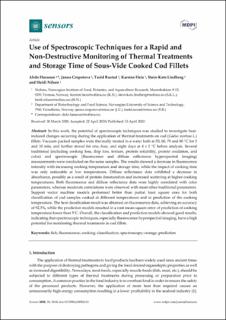| dc.description.abstract | In this work, the potential of spectroscopic techniques was studied to investigate heat-induced changes occurring during the application of thermal treatments on cod (Gadus morhua L.) fillets. Vacuum-packed samples were thermally treated in a water bath at 50, 60, 70 and 80 °C for 5 and 10 min, and further stored for one, four, and eight days at 4 ± 1 °C before analysis. Several traditional (including cooking loss, drip loss, texture, protein solubility, protein oxidation, and color) and spectroscopic (fluorescence and diffuse reflectance hyperspectral imaging) measurements were conducted on the same samples. The results showed a decrease in fluorescence intensity with increasing cooking temperature and storage time, while the impact of cooking time was only noticeable at low temperatures. Diffuse reflectance data exhibited a decrease in absorbance, possibly as a result of protein denaturation and increased scattering at higher cooking temperatures. Both fluorescence and diffuse reflectance data were highly correlated with color parameters, whereas moderate correlations were observed with most other traditional parameters. Support vector machine models performed better than partial least square ones for both classification of cod samples cooked at different temperatures and in prediction of the cooking temperature. The best classification result was obtained on fluorescence data, achieving an accuracy of 92.5%, while the prediction models resulted in a root mean square error of prediction of cooking temperature lower than 5 °C. Overall, the classification and prediction models showed good results, indicating that spectroscopic techniques, especially fluorescence hyperspectral imaging, have a high potential for monitoring thermal treatments in cod fillets. | en_US |

